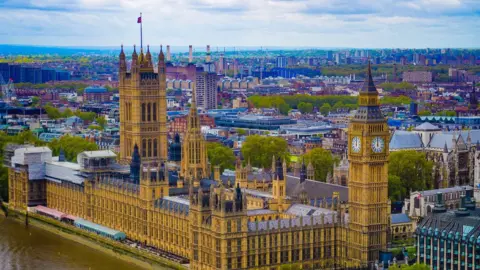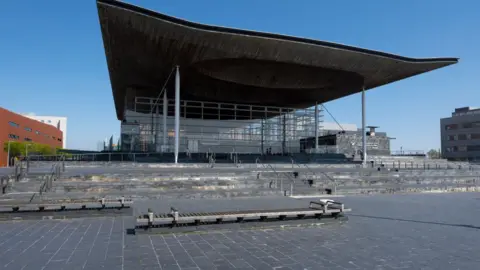Q&A: Why does the Welsh MP boundary review matter?
 Getty Images
Getty ImagesCouncils, constituencies, Senedd members, MPs - the world of politics could be boiled down to a series of maps for who represents who.
And now there's a fresh map, showing how Wales' 40 MPs will be reduced to 32, and the constituencies they will represent.
It has generated political controversy and opposition from Labour and Plaid Cymru.
But why is it happening?
What is a constituency?
Wales is represented in two parliaments - one in Cardiff and one in Westminster.
In Westminster, Members of Parliament represent constituencies - areas of the country which have defined boundaries.
These have been decided by impartial boundary commissions, looking at how the number of voters in areas have changed and making adjustments to borders and names.
But this process has been delayed in recent years.
Why does the government want to do this?
The shake-up was triggered by the Conservative UK government in a bid to make constituencies roughly the same size, while keeping the number of MPs the same.
They argue it will make everyone's vote fairer, because it will give each vote roughly equal worth as a vote in another constituency.
Commissions in each UK nation have looked at the new rules and drawn up boundaries for new seats.
The latest process is a major overhaul - the Boundary Commission for Wales itself says it is the most significant change to Wales' Westminster constituencies in a century.
Why does it affect Wales this way?
It's because Wales has some of the smallest constituencies in the UK - on average they are smaller than those in England.
While the Anglesey seat of Ynys Môn is protected, when you apply the maths of the review it is inevitable that some constituencies will have to be significantly withdrawn.
Seats in Great Britain have to have between 69,724 and 77,062 voters. Arfon, according to 2020 figures, had just 40,999 voters - the smallest constituency on mainland Great Britain by electorate.
 Getty Images
Getty ImagesWhy does Wales have smaller constituencies?
A Commons paper from 2010 said Wales' overrepresentation was effectively institutionalised after the Second World War, when the old rules for boundary reviews were drawn up.
Reviews were previously obliged to draw up at least 35 constituencies in Wales.
The average number of voters permitted for each constituency was also lower in Wales than England and Scotland.
In the past it was argued that Wales, as a small nation, needed to be overrepresented in the Commons to make its voice heard there.
But there have also been claims it's unfair - a 2010 paper from the centre-right think tank Policy Exchange argued there was "no democratic justification" for it with devolution in place.
 EPA
EPAWhy do the changes matter?
Unless you live in Ynys Môn the constituency and the area that your MP represents will change.
Opponents of the boundaries review argue it will leave Wales with less of a say in Westminster, with fewer MPs representing its interests.
There are concerns from Labour that the way it is being carried out will break community ties, because it will be harder for boundary commissioners to draw constituencies that accurately reflect the communities that people live in.
Not all Welsh constituencies represent their communities perfectly now - take Carmarthen, for instance, split in two across two large rural seats.
But the new map sees the post-industrial Swansea valley added to the existing rural constituency of Brecon and Radnor - two areas that have distinctive characters of their own.
Part of Cynon Valley is split off to join the new constituency of Merthyr Tydfil and Aberdare, while the rest of it joins Pontypridd. They are not the only examples in a complicated set of changes.
 Getty Images
Getty ImagesWhat will it mean for the MPs and the parties?
Internal selection battles can result in local political drama, and if there are fewer MPs some politicians in Wales could face a fight to gain re-selection.
It could, potentially, also change the political make-up of your constituency.
How does this affect the Senedd?
The new boundaries will be used by the Senedd to draw up the 16 constituencies of the 2026 Welsh Parliament, under current plans.
Each constituency will be paired with another, and will be served by six MSs elected through a list system.
The Senedd changes are yet to become law and are expected to be subject of legislation later this year.
